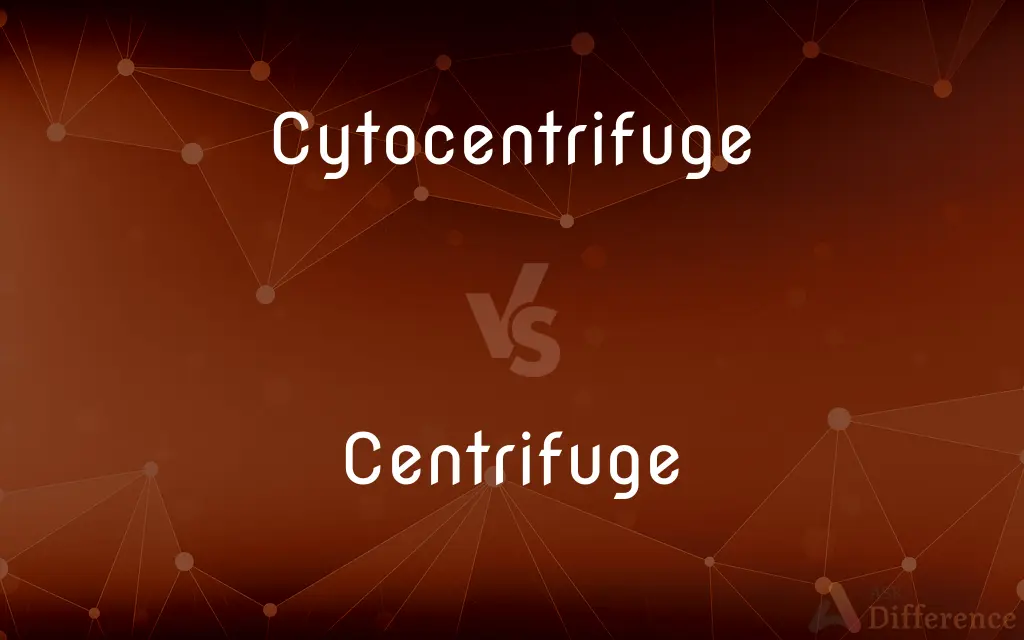Cytocentrifuge vs. Centrifuge — What's the Difference?
Edited by Tayyaba Rehman — By Maham Liaqat — Updated on March 9, 2024
A cytocentrifuge specializes in concentrating cells for microscopic examinations, maintaining cell integrity, while a centrifuge broadly separates mixtures based on density, used in various scientific fields.

Difference Between Cytocentrifuge and Centrifuge
Table of Contents
ADVERTISEMENT
Key Differences
A cytocentrifuge is designed for cytology, aiming to deposit cells onto a slide in a concentrated form while preserving their morphology. This is crucial for accurate diagnosis and research in fields like hematology and oncology. In contrast, centrifuges are used across a wider range of scientific disciplines, including biology, chemistry, and physics, to separate components of a mixture, such as DNA samples, or chemical compounds, based on density differences.
The operating principle of a cytocentrifuge involves lower speed and shorter duration spins to gently concentrate cells without causing significant damage. This gentle approach is essential for preparing samples for microscopic examination, where cell structure needs to be intact. Conversely, centrifuges can operate at much higher speeds and are capable of generating significant centrifugal forces, designed to efficiently separate mixtures into their constituent parts, regardless of the potential impact on cell integrity.
Cytocentrifuges are particularly valuable in clinical laboratories and research settings where the examination of cell morphology is necessary. For instance, they are instrumental in preparing slides for cancer diagnostics, where the detailed examination of cell structure can indicate the presence of malignant cells. On the other hand, centrifuges are versatile tools used not only in medical and research laboratories but also in industrial processes and even in culinary applications, showcasing their broad applicability beyond cell analysis.
One of the key differences lies in the specific accessories and adaptations. Cytocentrifuges often come equipped with specialized chambers and slides designed for capturing and presenting cells in a way that is optimal for microscopic analysis. Meanwhile, centrifuges might come with a variety of rotor types and tube sizes, accommodating a wide range of sample volumes and separation requirements, from microcentrifuges for small sample sizes to large floor models for high-volume processing.
Despite their differences, both cytocentrifuges and centrifuges share the fundamental principle of using centrifugal force to achieve their objectives. However, the precision and purpose of a cytocentrifuge in preparing cell samples for detailed morphological examination distinguish it from the more broadly applied centrifuge, which focuses on the efficient separation of substances based on density differences.
ADVERTISEMENT
Comparison Chart
Primary Use
Concentrating cells for microscopic examination
Separating mixtures based on density
Speed
Lower speeds
Wide range of speeds, including very high speeds
Sample Damage
Minimal, preserves cell integrity
Variable, may disrupt cell structure
Applications
Cytology, hematology, oncology
Biology, chemistry, physics, industry
Specialized Equipment
Yes, slides and chambers for cell deposition
Yes, various rotors and tubes for separation
Compare with Definitions
Cytocentrifuge
A device for concentrating cells onto slides with minimal damage.
The lab used a cytocentrifuge to prepare samples for cancer diagnosis.
Centrifuge
Operates at various speeds for diverse applications.
High-speed centrifuges can separate blood components efficiently.
Cytocentrifuge
Preserves cell morphology for detailed examination.
Cytocentrifuges help in analyzing the morphology of cells in fluid specimens.
Centrifuge
Equipment for separating substances based on density.
The scientist used a centrifuge to isolate DNA from a test sample.
Cytocentrifuge
Used primarily in medical and research labs.
Research on diseases often requires cytocentrifugation for cell sample preparation.
Centrifuge
Versatile tool in labs and industries beyond biology.
Centrifuges are used in wastewater treatment plants to separate solids.
Cytocentrifuge
Low-speed centrifugation focusing on cell integrity.
Using a cytocentrifuge, the technician obtained clear cell images for analysis.
Centrifuge
Can cause disruption of cell structures at high speeds.
Centrifugation at high speeds may damage delicate cells.
Cytocentrifuge
Essential in diagnosing diseases through cytology.
Cytocentrifuges are crucial for detecting abnormal cells in pleural effusions.
Centrifuge
Accommodates a wide range of sample volumes.
Microcentrifuges are designed for small-volume biochemical analyses.
Cytocentrifuge
(biology) A low-speed, low-acceleration centrifuge used to separate cellular material without damaging it
Centrifuge
A centrifuge is a device that uses centrifugal force to separate various components of a fluid. This is achieved by spinning the fluid at high speed within a container, thereby separating fluids of different densities (e.g.
Cytocentrifuge
A cytocentrifuge, sometimes referred to as a cytospin, is a specialized centrifuge used to concentrate cells in fluid specimens onto a microscope slide so that they can be stained and examined. Cytocentrifuges are used in various areas of the clinical laboratory, such as cytopathology, hematology and microbiology, as well as in biological research.
Centrifuge
An apparatus consisting essentially of a compartment spun about a central axis to separate contained materials of different specific gravities, or to separate colloidal particles suspended in a liquid.
Cytocentrifuge
To separate cellular material in such a device
Centrifuge
An apparatus in which humans or animals are enclosed and which is revolved to simulate the effects of acceleration in a spacecraft.
Centrifuge
To rotate (something) in a centrifuge or to separate, dehydrate, or test by means of this apparatus.
Centrifuge
A device in which a mixture of denser and lighter materials (normally dispersed in a liquid) is separated by being spun about a central axis at high speed.
Centrifuge
(figuratively) An apparatus in which humans are spun to simulate acceleration in an aircraft or spacecraft.
Centrifuge
To rotate something in a centrifuge, typically in order to separate its constituents.
Centrifuge
An apparatus having containers for liquids arrayed around a central pivot and rotated at a high speed, thus generating centrifugal force on the liquid, and separating substances (such as particles of solid or globules of an immiscible liquid) mixed together in suspension within the liquid. Suspensions which would settle only very slowly or not at all under gravity can be made to separate quickly in such a device.
Centrifuge
To drive out; to subject to the action of a centrifuge.
Centrifuge
An apparatus that uses centrifugal force to separate particles from a suspension
Centrifuge
Rotate at very high speed in order to separate the liquids from the solids
Common Curiosities
What is the main purpose of a cytocentrifuge?
A cytocentrifuge concentrates cells onto slides for microscopic examination, preserving cell morphology for accurate diagnostics.
How does a centrifuge work?
A centrifuge separates substances of a mixture by spinning at high speeds, leveraging centrifugal force to distribute components based on density.
What makes a cytocentrifuge different from a regular centrifuge?
A cytocentrifuge operates at lower speeds and has specialized attachments to preserve and prepare cells for microscopic examination, unlike a regular centrifuge which focuses on separating mixtures based on density.
Is a cytocentrifuge necessary for cytology?
Yes, a cytocentrifuge is crucial in cytology for preparing cell samples in a manner that preserves their morphology, allowing for accurate examination and diagnosis.
Can a centrifuge be used for cell analysis?
While a centrifuge can separate cells from a mixture, it may not preserve cell integrity as well as a cytocentrifuge, which is specifically designed for cell analysis.
How does centrifugal force apply to cytocentrifugation?
In cytocentrifugation, centrifugal force gently deposits cells onto a slide, minimizing damage and preserving cell structure for analysis.
Are all centrifuges capable of cytocentrifugation?
Not all centrifuges are suited for cytocentrifugation; specific cytocentrifuges are designed with features to gently concentrate cells and preserve their integrity for microscopic examination.
What samples can be processed in a cytocentrifuge?
Cytocentrifuges can process various fluid specimens containing cells, such as urine, and pleural effusions, for cytological examination.
Can I use a cytocentrifuge for DNA extraction?
While a cytocentrifuge is primarily designed for cell concentration and morphology preservation, DNA extraction typically requires a centrifuge to separate cellular components.
What industries use centrifuges?
Centrifuges are used in a wide range of industries, including pharmaceutical, biotechnology, chemical manufacturing, and food processing, for various separation tasks.
Share Your Discovery

Previous Comparison
Polycarbonate vs. Polysulfone
Next Comparison
Bruxomania vs. BruxismAuthor Spotlight
Written by
Maham LiaqatEdited by
Tayyaba RehmanTayyaba Rehman is a distinguished writer, currently serving as a primary contributor to askdifference.com. As a researcher in semantics and etymology, Tayyaba's passion for the complexity of languages and their distinctions has found a perfect home on the platform. Tayyaba delves into the intricacies of language, distinguishing between commonly confused words and phrases, thereby providing clarity for readers worldwide.














































